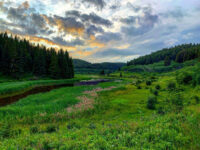Beetle dangerous to lilies has been found in city
By Jensen, Randy on August 27, 2020.
 An adult red lily beetle, one of a number of the invasive pests found in a Lethbridge yard recently. Photo by David Shack/AAFC-Lethbridge
An adult red lily beetle, one of a number of the invasive pests found in a Lethbridge yard recently. Photo by David Shack/AAFC-LethbridgeTim Kalinowski
Lethbridge Herald
tkalinowski@lethbridgeherald.com
A scarlet menace of the insectoid type has been discovered in Lethbridge for the first time, and local gardening enthusiasts are being warned to keep an eye on their lilies.
About a dozen scarlet lily beetles, also known as red lily beetles, were discovered in a garden at a westside home this past week. Haley Catton, a research scientist specializing in insects at the Agriculture and Agri-Food Canada Lethbridge Research and Development Centre, verified the discovery after a colleague of hers found the pest in his neighbour’s yard. Handpicking is actually the best way to get rid of them if they exist in small numbers, she says.
“The adults are bright scarlet red,” she explains. “They are actually quite beautiful. But if you see them, don’t confuse them with lady beetles. These lily beetles do not have spots. So make sure you have the right insect, and then squish them; or you can drop them in a bucket of soapy water if you don’t like to squish.”
Scarlet lily beetles were first discovered in Eastern Canada in the 1940s, and have been making their way west ever since, Catton explains. The adults actually fly, but larvae or eggs can also be transported on plants brought in from other regions.
“What we are talking about here is a beetle from Eurasia, and it has been in Canada for a number of decades,” she says. “But was not known in Lethbridge yet. As the name suggests, it eats lilies. It can destroy lily plants in your garden very quickly.
“We knew it was coming,” Catton adds ominously. “It has been in Calgary for about six years, and Saskatchewan for about five years. But in Lethbridge, to our knowledge, we hadn’t seen it yet until now.”
The beetle feeds on the leaves of lily plants putting holes in them and thereby killing them, confirms Catton.
“The babies are actually even more voracious than the adults,” she says. “The babies, the larvae, don’t look anything like the adults. They almost look like slugs, and they actually carry their own feces on their back for protection as a fecal shield, which is really weird. They absolutely destroy leaves and eat plants quite quickly.”
Catton confirms the beetle prefers true lilies, like frigelarius or lily-of-the-valley, but can also sometimes be found on other plants like hosta lily, flowering tobacco, hollyhock and, most worryingly for southern Alberta, potato plants.
“They can’t complete their life cycle on potatoes,” she says, “but they feed on potatoes when there are so many beetles breeding on lilies, they can’t all fit. It is like more of a spillover feeding. I wouldn’t expect potato-feeding if they are at low-population levels, but if the population explodes there could be some spillover feeding on potatoes. It is definitely something which is going to have to be watched for.”
Catton says there is a parasitic wasp which has already been released near Brooks which likely represents the strongest long-term control of the beetles, but until those wasps get established in the region, handpicking for low numbers is still the best control option.
“What we recommend is if you just have a few plants, check them,” she says. “If you see any adults, larvae, or eggs even, squish them. Handpicking is the very best and easiest thing to do. If you have a lot of plants then you need to look into other sprays.”
Follow @TimKalHerald on Twitter
18-17




